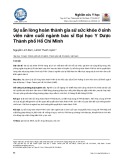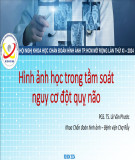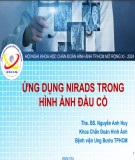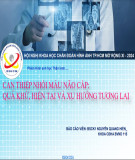Available online http://ccforum.com/content/7/3/243
Letter Intramucosal–arterial PCO2 gap does reflect tissue dysoxia Guillermo Gutierrez1 and Hulya Turkan2
1Professor of Medicine and Anesthesiology, Director, Pulmonary and Critical Care Medicine Division, The George Washington University, Washington, District of Columbia, USA 2Associate Professor of Anesthesiology, Department of Emergency Medicine, Division of Anesthesiology, Gulhane Military Medical Academy and Medical Faculty, Ankara, Turkey
Correspondence: Guillermo Gutierrez, ggutierrez@mfa.gwu.edu
Critical Care 2003, 7:243-244 (DOI 10.1186/cc2170)
Published online: 13 March 2003 This article is online at http://ccforum.com/content/7/3/243 © 2003 BioMed Central Ltd (Print ISSN 1364-8535; Online ISSN 1466-609X)
Another parameter that may be used to determine the onset of an anaerobic state is the presence of increased H+ concentration in tissues and blood. Although both groups became acidaemic as oxygen delivery was decreased, it appears that the mechanism responsible for the low pH in the HH group was a respiratory acidosis, not the production of excess H+ by anaerobic tissues. The instillation of hydrochloric acid into the lungs of the HH animals probably produced extensive parenchymal damage and impaired carbon dioxide excretion. This is the probable cause of the low pH and increased PCO2 noted in the HH group.
In their recent paper, Dubin and coworkers [1] subjected anaesthetized, paralyzed sheep to decreases in oxygen delivery either by progressive bleeding (ischaemic hypoxia [IH] group) or by decreasing oxygen saturation (hypoxic hypoxia [HH] group). They found substantial increases in mesenteric venous–arterial blood partial carbon dioxide tension (PCO2) gradient (∆PCO2) in the IH group, whereas ∆PCO2 remained unchanged both in the HH and in a sham operated control group. The authors concluded that intestinal tonometry has limited value in detecting the presence of anaerobic metabolism in tissues. Dubin and colleagues should be congratulated on the soundness and quality of their experiments, but in our opinion the conclusion of the study may be at odds with the data presented.
Moreover, we note a decline in bicarbonate from 18.0 to 10.2 mmol/l in the IH group after 90 min of dysoxia. On the other hand, the bicarbonate concentration remained relatively constant at 16.5 and 15.3 mmol/l for the HH group and the control group, respectively. The decline in bicarbonate in the IH group reflects buffering of nonvolatile acids, probably lactic acid. These data again support the notion of a severe dysoxic insult in the IH group but not in the HH group. The fundamental premise of comparable anaerobic states for both groups is based on the presence of oxygen dependence. This premise, however, may not be correct because it appears from the data presented that animals in the HH group did not reach an anaerobic state, and thus were unable to mount increases in ∆PCO2.
∆PCO2 = mesenteric venous–arterial blood PCO2 gradient; HH = hypoxic hypoxia; IH = ischaemic hypoxia; O2ER = oxygen extraction ratio; PCO2 = partial carbon dioxide tension; RER = respiratory exchange ratio.
243
When calculating oxygen extraction ratios (O2ER) from Fig. 1 of the paper, we find that maximal values for systemic and gut O2ER for the HH group were 48% and 59%, respectively. These values are lower than those reported for critical ERO2 in dogs [2], supporting our contention that animals in the HH group might not have reached a critical oxygen supply condition. Of note, the maximal gut O2ER in the sham control group was 51% – a value not too dissimilar from that in the HH group. Conversely, maximal systemic and gut O2ER levels for the IH group were much higher, at 83% and 90%, respectively, suggesting that these animals experienced greater hypoxic stress. Finally, one can infer the degree of excess carbon dioxide production from the respiratory exchange ratio (RER), which is defined as the ratio of carbon dioxide production to oxygen consumption. In aerobic tissues, RER depends on the substrate consumed and its value is ≤ 1.0. During anaerobic metabolism, additional carbon dioxide generated by the buffering of excess H+ may result in RER in excess of 1.0. We calculated RER as (change in carbon dioxide content)/(O2ER × arterial oxygen content) and found that RER for the IH group was 1.1 at 30 min and continued to rise to 1.7 for the remainder of the experiment. This is convincing proof that these animals were anaerobic and produced excess carbon dioxide. Conversely, systemic RER for the HH
Critical Care June 2003 Vol 7 No 3 Gutierrez and Turkan
3.
2. Nelson DP, King CE, Dodd SL, Schumacker PT, Cain SM: Sys- temic and intestinal limits of O2 extraction in the dog. J Appl Physiol 1987, 63:387-394. Vallet B, Teboul JL, Cain S, Curtis S: Venoarterial CO2 differ- ence during regional ischemic or hypoxic hypoxia. J Appl Physiol 2000, 89:1317-1321.
4. Neviere R, Chagnon JL, Teboul JL, Vallet B, Wattel F: Small intestine intramucosal PCO2 and microvascular flow during hypoxic and ischemic hypoxia. Crit Care Med 2002, 30:372- 384.
group, as well as that for the sham operated group, remained below 1.0 throughout the experiment, suggesting that the tissues were not anaerobic. Although there is some noise in the data, the same findings hold true for regional RER.
The above arguments support our hypothesis that ∆PCO2 in these experiments was compared at different degrees of dysoxia. It possible, however, that the conclusion reached by Dubin and coworkers may be correct, in that arteriovenous ∆PCO2 fails to increase during HH. This conclusion was also reached by Vallet and coworkers [3] when they measured arteriovenous ∆PCO2 in the dog hindlimb.
The concentration of an effluent species in a compartment depends on the mass balance between the rates of production and elimination. As flow increases, the difference between affluent and effluent concentrations will decrease, although the total mass leaving the system remains constant. In other words, higher flows will result in lower arteriovenous ∆PCO2.
A similar reasoning may not hold true for the arterio- tonometer ∆PCO2, because the latter is an integrative process that allows equilibration of the tonometer fluid with tissue PCO2. Tissue PCO2 depends on convective as well as on diffusive processes. Whereas the former is a function of total organ blood flow, the latter is a function of microcirculatory phenomena and the ability of carbon dioxide to diffuse across tissues – processes that are often disturbed in disease states. Therefore, it may be possible for arteriovenous ∆PCO2 to remain relatively constant during tissue HH but (as shown by Neviere and coworkers [4]) for tonometer ∆PCO2 to increase in response to excess tissue carbon dioxide production.
Another important issue raised by this excellent paper concerns the physiological significance of oxygen dependence. In other words, is oxygen dependence an infallible marker of anaerobic metabolism? If the answer is ‘no’, as appears to be the case in these experiments, then why did oxygen consumption decline in the HH group, even though other markers of tissue oxygenation suggest that these animals were not in an anaerobic state? Are there compensatory mechanisms to lower tissue metabolic rate and to decrease oxygen consumption in response to hypoxaemia?
These are complex questions that await further experimental studies similar to the excellent work of Dubin and colleagues [1].
Competing interests None declared.
References 1. Dubin A, Murias G, Estenssoro E, Canales H, Badie J, Pozo M, Sottile JP, Baran M, Palizas F, Laporte M: Intramucosal–arterial PCO2 gap fails to reflect intestinal dysoxia in hypoxic hypoxia. Crit Care 2002, 6:514-520.
244




































